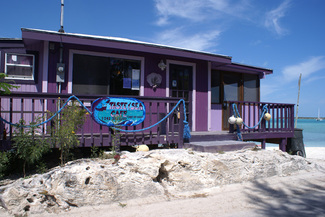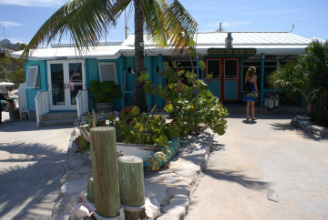Thunderball Grotto |
Swimming Pigs |
Compass Cay / Sharks |
Visit the Iguanas |
A Special Alert on Feeding the Iguanas...
Don’t feed the iguanas
FEEDING wildlife is an increasingly common tourist activity, especially on Allens Cay and other Family Islands. But a new study published online by the journal Conservation Physiology by Dr Charles Knapp, PhD, of the John G Shedd Aquarium in Chicago, and a team of researchers shows that endangered iguanas are suffering further physiological problems as a result of being fed by tourists and locals. The two-year study compared rock iguanas living on tourist-visited islands and those living on non-tourist-visited islands and the physiological differences and infection rates. Blood and fecal samples were collected from both male and female iguanas during two research trips in 2010 and 2012.
The Bahamian rock iguana is among the world’s most endangered lizards due to habitat loss, introduced mammals, illegal hunting, threats related to increased tourism, and smuggling for the illicit pet trade. As a result, the Bahamian rock iguana is listed on the IUCN Red List of Threatened Species. The researchers also discovered that iguanas on tourist-visited islands had a higher infection rate than those on other islands not visited by tourists .
We are aware that it is very difficult to completely restrict feeding the iguanas, the research suggests that tour operators and guests use pellets to feed the iguanas rather than giving them human foods. (from a Bahamas Tribune article on 1/9/13)
FEEDING wildlife is an increasingly common tourist activity, especially on Allens Cay and other Family Islands. But a new study published online by the journal Conservation Physiology by Dr Charles Knapp, PhD, of the John G Shedd Aquarium in Chicago, and a team of researchers shows that endangered iguanas are suffering further physiological problems as a result of being fed by tourists and locals. The two-year study compared rock iguanas living on tourist-visited islands and those living on non-tourist-visited islands and the physiological differences and infection rates. Blood and fecal samples were collected from both male and female iguanas during two research trips in 2010 and 2012.
The Bahamian rock iguana is among the world’s most endangered lizards due to habitat loss, introduced mammals, illegal hunting, threats related to increased tourism, and smuggling for the illicit pet trade. As a result, the Bahamian rock iguana is listed on the IUCN Red List of Threatened Species. The researchers also discovered that iguanas on tourist-visited islands had a higher infection rate than those on other islands not visited by tourists .
We are aware that it is very difficult to completely restrict feeding the iguanas, the research suggests that tour operators and guests use pellets to feed the iguanas rather than giving them human foods. (from a Bahamas Tribune article on 1/9/13)


